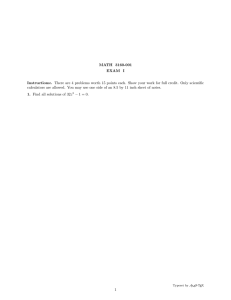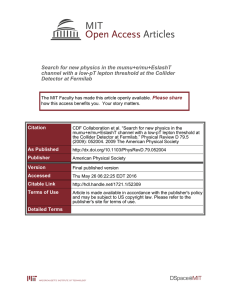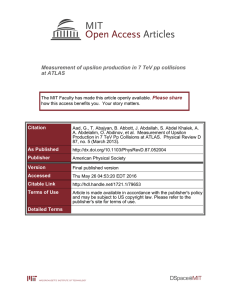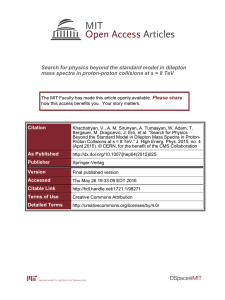Search for Narrow Dimuon Resonances at CDF High Energy Physics Seminar
advertisement
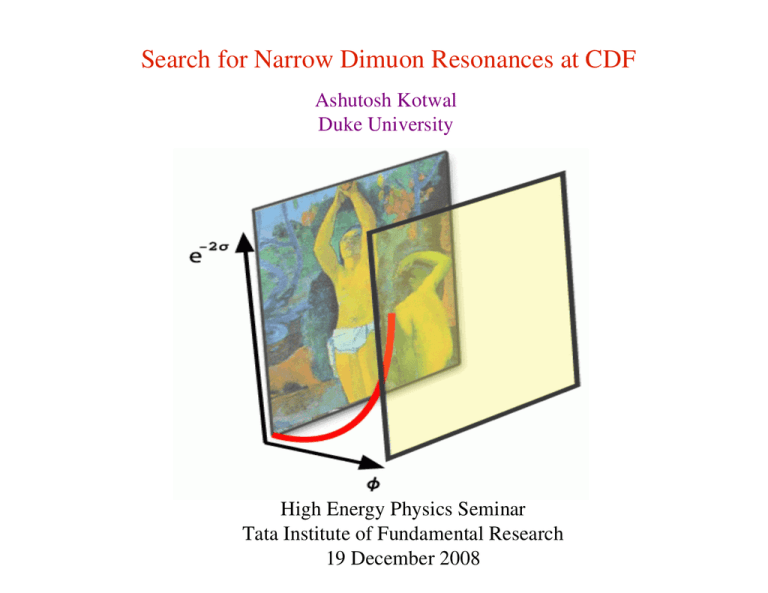
Search for Narrow Dimuon Resonances at CDF Ashutosh Kotwal Duke University High Energy Physics Seminar Tata Institute of Fundamental Research 19 December 2008 Motivation Dilepton resonances have a strong track record for discovery J/ψ, Υ, Z Motivation continues at higher energy: Unification of fermions/forces in the context of grand unified theories / String Theory typically based on extended gauge group, eg. SO(10), E6 Symmetry-breaking of larger gauge group to SM groups generates additional U(1) gauge groups in intermediate stages, eg. E6 SO(10) + U(1)ψ SU(5) + U(1)ψ + U(1)χ The breaking of these intermediate U(1) gauge symmetries produces heavy Z' bosons Coupling of O(αEW) implies small width/mass ratio Gravity also enters the game Randall-Sundrum model of “gravity unification” Motivation i.e. Ameliorating the problem of large hierarchy between electroweak symmetry breaking energy scale and Planck mass scale a.k.a. “why is gravity so much weaker than electroweak force?” Suggested solution: its not really, but just appears to be so weak... 4 4 Randall and Sundrum, PRL 83 (1999) 3370 Randall-Sundrum prescription Motivation Construct Gravitational Lagrangian in bulk and on branes Derive equation of motion for the metric, from principle of stationary action Solve for metric gµν: Randall-Sundrum prediction: Motivation Ground-state wave function of graviton small on our brane, ie gravity appears weak But excited states of graviton wave function has big overlaps, ie. Massive Kaluza-Klein gravitons with electroweak-strength couplings to SM particles on our brane Models of new physics also contains scalar particles Motivation Higgs bosons with enhanced couplings to muons Supersymmetric partner of neutrino in R-parity violating SUSY models: s-channel resonant production of sneutrino, decaying to dimuons We use sneutrinos, Z', and Gravitons as examples of new particles with spin 0, 1 and 2 respectively Particle spin affects the angular distribution of decay muons and the detector acceptance Methodology Using the Z' resonance as an example, we scan the dimuon mass spectrum using simulated templates generated as a function of Z' mass For each Z' mass, we scale the expected dimuon mass distribution so as to vary its integrated number of Z' events, N(Z'). The total expected distribution in dimuon mass is obtained by adding the (scaled) Z' template distribution and the standard model and misidentification background distributions The total expected distribution is normalized to the data in the Z mass peak region. The binned poisson likelihood is computed between the total expected distribution and the data distribution in dimuon mass. At each Z' pole mass, we compute the total poisson likelihood over all data bins, as a function of N(Z') Systematic uncertainties are correlated across the bins and are incorporated as nuisance parameters Nuisance parameters are varied by expected uncertainty and averaged over We use the total poisson likelihood to compute the interval for N(Z') at any specified confidence level Methodology Feldman-Cousins prescription is used to construct the interval The prescription automatically chooses 1-sided or 2-sided interval depending on whether N(Z')=0 is excluded We obtain the “maximum-likelihood” estimate of N(Z') and its confidence interval at each value of the Z' pole mass Quadrant of Collider Detector at Fermilab (CDF) EM calorimeter provides precise electron energy measurement Central hadronic calorimeter Central electromagnetic calorimeter η=1 . COT provides precise lepton track momentum measurement Calorimeters measure hadronic recoil particles Select events with two central ( | η | < 1 ) muons Collider Detector at Fermilab (CDF) Muon detector Central hadronic calorimeter Central outer tracker (COT) Drift Chamber (COT) Alignment Use a clean sample of ~200k cosmic rays for cell-by-cell internal alignment Fit COT hits on both sides simultaneously to a single helix (AK, H. Gerberich and C. Hays, NIMA 506, 110 (2003)) Internal Alignment of COT Time of incidence is a floated parameter in this 'dicosmic fit' Residuals of COT cells after alignment CDFII preliminary Residual (microns) Before alignment Cell number (φ) after alignment Cell number (φ) Final relative alignment of cells ~5 µm (initial alignment ~50 µm) Signal Simulation and Fitting Signal Simulation and Template Fitting All signals simulated using a fast Monte Carlo Generate finely-spaced templates as a function of the resonance pole mass perform binned maximum-likelihood fits to the data Custom fast Monte Carlo makes smooth, high statistics templates And provides analysis control over key components of the simulation WGRAD Z' PYTHIA l Generator-level input for W & Z simulation provided by PYTHIA Radiative photons generated according to energy vs angle lookup table from WGRAD (U. Baur, S. Keller & D. Wackeroth, PRD59, 013002 (1998)) A complete detector simulation of all quantities measured in the data First-principles simulation of tracking At each material interaction, calculate Tracks and photons propagated through a high-resolution 3-D lookup table of material properties for silicon detector and COT Fast Monte Carlo Detector Simulation Ionization energy loss according to complete Bethe-Bloch formula Simulate multiple Coulomb scattering, including non-Gaussian tail Deposit and smear hits on simulated COT wires, perform full helix fit including beam-constraint Mass resolution vs mass Tracking resolution of muon momentum degrades rapidly as mass and pT increase, as ∆pT ~ pT2 Rapidly varying resolution makes fixed binning sub-optimal at either low mass or high mass – ideally want variable mass binning such that Z' propulates a fixed number of bins at any mass Fractional mass resolution vs mass Detector resolution dominates Z boson intrinsic width of 2.8% Mass-1 resolution vs mass ! Tracking resolution of muon momentum ∆(1/pT) ~ constant Instead of the dimuon mass distribution, we choose to work with the dimuon (1/mass) distribution, where resolution ~ constant Resolution approximately independent of mass Mass resolution is 16% at 1 TeV Events/10 GeV Monte Carlo Pseudo-Experiment L ~ 2 / fb # " Dimuon mass (GeV) simulated Standard Model (Drell-Yan) background (RED) and Monte Carlo pseudo-experiment (BLUE) with SM + Z' (900 GeV) PYTHIA used as generator Events/(0.3 TeV-1) Monte Carlo Pseudo-Experiment L ~ 2 / fb $ Dimuon 1/mass (TeV-1) Simulated SM (Drell-Yan) background (RED) and SM pseudo-experiment (BLUE) Integral of Z' template = number of Z' events N(Z') Perform maximum likelihood fit to data for N(Z'), using sum of background and Z' template shapes ' & % Mass Peak Fitting Poisson probability per bin, product over bins Z' MC * ) ( Technique We normalize all backgrounds to the data in the control region of the Z boson mass peak: 70 < mµµ < 100 GeV We use the fast simulation to generate resonance templates Validate the acceptance and efficiency calculation of the fast simulation as a function of track momentum or dimuon mass, by comparing to data or detailed GEANT-based simulation Measure and correct the fast simulation for momentum-dependent identification efficiency measured from data , + Muon Identification Efficiency Use Z boson data, tagged with one well-identified muon and one looselyidentified track, use the latter for measuring efficiency 1 0 / . - Backgrounds SM Drell-Yan dominant by far: generated from PYTHIA and simulated with fast simulation WW and ttbar from PYTHIA using GEANT simulation of detector fitted time of drift chamber track at beamline is called t0 assuming outgoing direction Normalization of cosmic ray bkg Cosmic rays Jet fakes Decays-in-flight Difference of t0 between two candidate tracks Jet fakes = punch-throughs + combinatoric + heavy-flavor decays “Muon” track momentum is correctly measured Same-sign data with loose cuts Shape obtained from jet triggers Decay-in-flight component from “kinked” tracks when decay occurs in COT active volume 6 5 4 3 2 Jet Fakes and Decays-in-Flight Backgrounds Kink causes large mismeasurement of track momentum (dimuon mass (TeV))-1 COT Hit Pattern Cut for Decays-in-flight A “transition” implies consecutive hits on opposite sides of the fitted track Prompt primary muons Decays-in-flight 7 Jet Fakes and Decays-in-Flight Backgrounds Decay-in-flight component suppressed by COT-based cuts: track χ2, ∆z0, pattern of hit residuals Same-sign data with tighter cuts (dimuon mass (TeV))-1 Uncertainties on luminosity and absolute acceptance and efficiency cancel, due to normalization of backgrounds to the Z boson control region Mass-dependent uncertainties only.. ? > = < ; : 9 8 Systematic Uncertainties PDFs: increase linearly to 16% at 1 TeV QCD k-factor: increase linearly to 9% at 1 TeV Electroweak radiative corrections: increase linearly to 3% at 1 TeV Total acceptance: increase linearly to 3% at 1 TeV Momentum scale and resolution: tuned on Z boson peak, negligible uncertainty Systematic uncertainties incorporated as nuisance parameters and integrated out in likelihood calculation Blind Analysis Followed “Blind Analysis” procedure: analysis method approved in CDF and frozen, prior to unblinding the data ArXiv:0811.0053 Search region Normalization region Data-Background Agreement Generally good agreement between data and backgrounds in the search region (Data – background) / statistical error Momentum scale slightly off on Z peak Search region Normalization region Best-Fit and Confidence Intervals on Potential Signal At each value of Z' pole mass, the point shows the best fit value of Z' signal events Fitted number of Z' events Error bar shows the 95% C.L. Interval on N(Z'), built using Feldman-Cousins prescription 1/[ ] Dielectron Search An independent analysis at CDF of the dielectron mass spectrum 3.8σ excess at 240 GeV 2.5σ significance including “trials factor” CDF Run II ArXiv:0810.2059 Z' Cross Section and Mass Limits Convert N(Z') limit to Z' cross section limit, by incorporating mass-dependent acceptance and number of Z boson events observed p-value of most significant “excess” = 6.6% Z' Cross Section and Mass Limits Convert N(Z') limit to Z' cross section limit, by incorporating mass-dependent acceptance and number of Z boson events observed Z' Mass Limits Z' mass lower limits at 95% CL in specific models (eg. E6-inspired models specifying left- and right-handed couplings to u and d quarks and leptons): Z'SM 1030 GeV Z'ψ 878 GeV Z'χ 892 GeV Z'η 904 GeV Z'Ι 789 GeV Z'sec 821 GeV Z'N 861 GeV Sneutrino & Graviton Acceptance Incorporate spin-dependence of acceptance include different graviton polarizations for qq Sneutrino G and gg G Graviton Sneutrino & Graviton Mass Limits Lower mass limits at 95% CL Spacetime curvature in the extra spatial dimension in the Randall-Sundrum model is given by k2 BR denotes the sneutrino branching ratio to muons, λ is the qq-sneutrino coupling @ Summary search for narrow dimuon resonance in 2.3 fb-1 at CDF C B A Data consistent with Drell-Yan expectation and other (small) backgrounds Most significant “excess” occurs with p-value of 6.6% Most stringent limits on spin 0, 1 and 2 resonances at high mass
